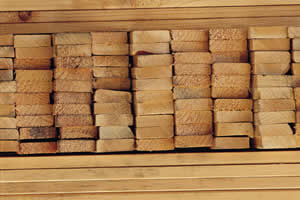Because of the availability of lumber, in most parts of North America, the most popular choice has always been wood-frame construction. Approximately 80 percent of the homes built are structured in wood.

Figure 1 - Lumber
Houses of timber were built when North America was in its infancy and many of these houses, now more than 200 years old, are still standing. Today, both traditional and daring contemporary houses are constructed of this handsome, durable and relatively inexpensive building material.
Wood is not only used structurally as the support of the house (its "frame") but is used in siding, in the window frames, roofing and flooring. Wood, being easily worked by a novice and readily available is the recommended choice for those considering building a home, addition, garage or shed. A house constructed of wood is easily repaired, altered and expanded; its component parts are lightweight and combine easily.
Lumber:
"Boards" usually refer to pieces of wood that are less than 2 inches thick, as shown in Figure 1, whereas "lumber" is wood cut into standard structural sizes and is generally over 2 inches thick. The "nominal" (rough) size is what it is called in the yard and on architectural drawings (2 X 4, 2 X 6). The actual, dressed dimensions of the lumber you take home are smaller. (A 2 X 4 will be 1/2 inch smaller in width and thickness.) The reduction in the size of the lumber dimensions is justified as part of the milling process that standardizes the lumber sizes by planning all four surfaces to a smooth, uniform product. You pay for the nominal size, but buy the actual size.
Kiln-drying, which also plays a part in diminishing the size of the lumber, reduces the shrinkage that may take place in the finished house. The reduction in dimensions have been standardized, so that a 2 X 4 will always be exactly 1 1/2 inches by 3 1/2 inches, and a 1 X 12 will always measure 25/32 inch X 11 1/4 inches.
Table 1 gives the actual dimensions of the most common nominal sizes. The length of the board, by the way, is not affected. When you buy a 14 foot long board, it should measure 14 feet.
Nominal & Dressed Sizes Of Softwood Lumber |
||||
Boards |
Up to 12" wide |
1 1/4" 1 1/2" |
1 " 1 1/4" |
|
Lumber |
Thickness - 2", 3", 4"; width - up to 12" and over |
3" 4" 6" 8" 10" 12" over 12" |
2 1/2" 3 1/2" 5 1/2" 7 1/4" 9 1/4" 11 1/4" less 3/4" |
2 9/16" 3 9/16" 5 5/8" 7 1/2" 9 1/2" 11 1/2" less 1/2" |
Timbers |
5" thick and over |
|||
Decking |
Tongue-and-groove boards |
3" 4" |
2 1/2" 3 1/2" |
|
Lumber is sold in lengths up to 24 feet. Although you can have lumber cut to any size under 24 feet, it is more efficient to use it in the standard lengths in which it is sold - less waste and less labor. Yard lumber is commonly sold in lengths of 8, 10, 12, 14 and 16 feet. Lumber longer than 16 feet may be difficult to find in all areas and/or more costly. Lumber longer than 24 feet, whether cut from one piece or laminated, is very expensive and should not be needed for residential construction.
It is a good idea to plan the joists and rafters in modules of 2 feet so that you will not have to cut longer pieces down to size.
Note: Laminated means several thin layers of wood being bonded together to form on solid piece.
Types & Grades Of Lumber:
Many species of wood are used for construction purposes and each variety of tree is divided further into grades depending on the quality of the sample cut. Wood is classified as either softwood or hardwood (misleading terms, because they have absolutely nothing to do with the strength of the timber).
- Hardwoods are cut from deciduous trees (trees that lose their leaves in the winter) and are used primarily in the making of furniture, flooring and interior trim.
- Softwoods refer to lumber cut from conifers, or trees that have needles. This wood is used for structural framing. Examples of softwoods are southern pine, Douglas fir and hem-fir.
Note: Some softwood is used for furniture, trim and flooring.
Each type of wood (named after the tree from which it is cut) is further divided into grades. The building code writers and the lumber industry carefully grade the lumber on criteria of strength, usage and imperfections. Reading through the lists is much like reading the guidelines from the tax department. What complicates matters further is that you will be buying lumber from a small retail dealer, who will most likely stock only one variety of mixed unknown grade.
